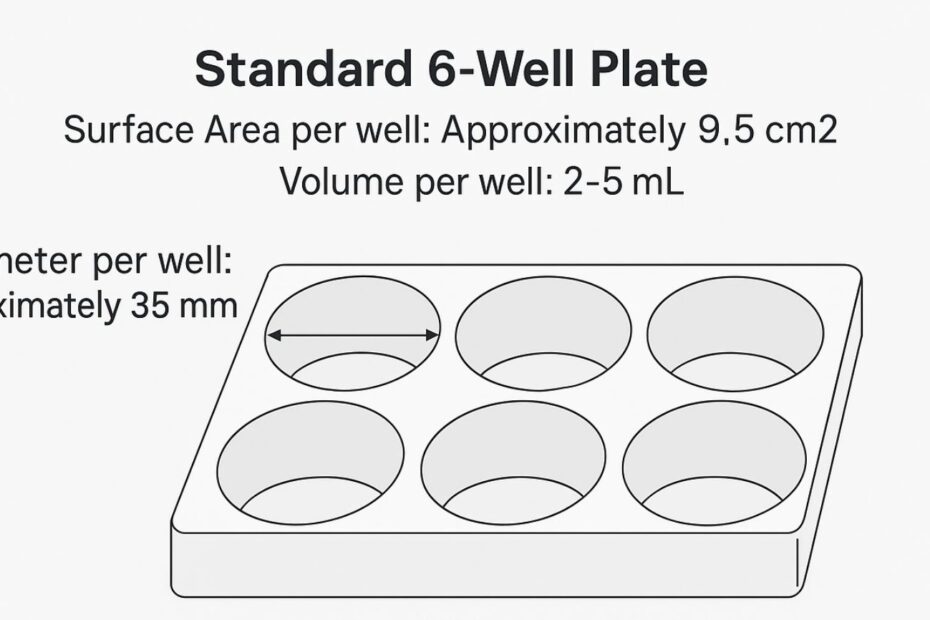When it comes to biological research, well plates are among the most versatile and essential tools for scientists. Selecting the correct well plate format directly impacts the accuracy and reliability of cell culture experiments, drug testing, and biochemical assays. Among the various well plate formats, the 6 well plate is favored for its optimal balance between surface area and experimental scalability.
We’ll cover everything from the role of surface area in cell culture experiments to a detailed look at the 6 well plate surface area and optimizing its use. If you’re a biologist, lab technician, or researcher looking to maximize your cell culture outcomes, this guide is for you.
What Are Well Plates and Why Are They Crucial in Biological Research?
Well plates, also referred to as microplates or multiwell plates, are flat plates with multiple wells used as small test tubes. Their design makes it easy to handle experiments that require multiple conditions or replicates in a single setup. Well plates come in a variety of formats, including common types such as 6 well plates, 12 well plates, 24 well plates, 48 well plates, 96 well plates, and 384 well plates.
Each well plate format serves a unique purpose depending on the type of experiment. For example:
- 6 well plate and 12 well plate are commonly used for cell culture, offering larger surface areas suitable for growing adherent cells.
- 24 well plate and 96 well plate are favored for high-throughput assays like enzyme-linked immunosorbent assays (ELISA).
Among these, the 6 well plate strikes a balance between adequate surface area for cell culture and the need for multiple experimental conditions.
Why is Surface Area Important in Cell Culture?
When working with adherent cell lines, surface area is crucial because these cells require a substrate to anchor themselves and grow. The surface area impacts:
- Cell Attachment: Adequate surface area ensures that there’s sufficient space for cells to adhere and spread out. This is especially important for experiments requiring confluent monolayers.
- Nutrient Distribution: The more surface area available, the better the distribution of nutrients and gases, which can directly affect cell health and proliferation.
- Consistency and Reproducibility: Knowing the exact surface area allows researchers to maintain consistency when scaling experiments or comparing data across well plates of different formats.
Ignoring surface area can lead to issues like uneven cell growth, poor experimental reproducibility, and unexpected outcomes. That’s why understanding the surface area of your specific well plate format, like the 6 well plate, is essential.
How Much Surface Area Does a 6 Well Plate Provide?
A standard 6 well plate Surface Area for each well is approximately 9.5 cm² (per well). Collectively, the total surface area of 6 well plate all six wells is around 57 cm². Here’s a breakdown of its key dimensions:
- Diameter per well: Approximately 35 mm
- Volume per well: Can hold a working volume of 2-5 mL, depending on the application

The generous surface area per well makes 6 well plates ideal for:
- Growing adherent cell lines that require more space
- Imaging-based experiments due to the wide flat bottom
- Producing protein or RNA in small batches
6 Well Plate Surface Area Compared to Other Formats
To truly appreciate the 6 well plate surface area, it’s helpful to compare it with other common well plate formats:
| Well Plate Format | Surface Area per Well | Total Surface Area | Working Volume (per well) |
| 6 Well Plate | ~9.5 cm² | ~57 cm² | 2-5 mL |
| 12 Well Plate | ~4.0 cm² | ~48 cm² | 1-2 mL |
| 24 Well Plate | ~1.9 cm² | ~45.6 cm² | 0.5-1 mL |
| 96 Well Plate | ~0.32 cm² | ~30.7 cm² | 0.2-0.4 mL |
As you can see, the 6 well plate provides significantly more surface area per well than smaller formats, making it suitable for applications where surface area takes priority over the number of wells.
Factors Affecting Cell Growth in 6 Well Plates
Even with a generous surface area, several factors affect how successfully cells grow in a 6 well plate setup:
- Coating of Well Surfaces: A specialized coating, such as collagen or poly-D-lysine, may be required for proper cell adherence depending on the cell type.
- Media Volume and Refresh Rate: Ensure that there’s enough media to cover the surface while allowing proper gas exchange.
- Incubator Conditions: Maintaining optimal temperature, CO₂ concentration, and humidity is key to cell health.
- Cell Density: Seeding density must be appropriate to avoid over-confluency or insufficient cell attachment.
Addressing these factors ensures a consistent and reproducible environment for cell culture experiments.
Tips for Optimizing Cell Culture in 6 Well Plates
Here are some actionable tips to maximize the potential of your 6 well plates:
- Pre-Treat the Wells: For sensitive cells, pre-treat wells with extracellular matrix (ECM) proteins to promote better adherence.
- Use Optimized Media Volumes: A working volume of 2-5 mL per well ensures adequate nutrient coverage without compromising oxygen exchange.
- Avoid Cross-Contamination: Handle wells carefully to prevent spillage or mixing of reagents between wells.
- Monitor Cell Growth: Regularly check for confluency under a microscope to avoid overgrowth, which may lead to nutrient depletion.
- Standardize Protocols: Document and follow consistent procedures for passaging, seeding density, and media replacement.
These small adjustments can make a significant difference in the outcomes of cell culture experiments.
Wrapping Up: Harness the Potential of 6 Well Plates in Your Lab
The 6 well plate is a powerful tool for researchers, offering the perfect balance between surface area and scalability. With approximately 9.5 cm² per well, it accommodates a variety of cell culture and imaging applications. When combined with proper optimization techniques and attention to detail, this format can elevate the reliability and reproducibility of your experiments.Whether you’re comparing 6 well plate surface area with other formats or refining protocols, understanding these fundamentals is essential for any researcher.

